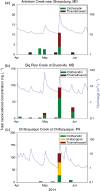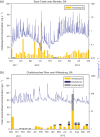The environmental risks of neonicotinoid pesticides: a review of the evidence post 2013
- PMID: 28593544
- PMCID: PMC5533829
- DOI: 10.1007/s11356-017-9240-x
The environmental risks of neonicotinoid pesticides: a review of the evidence post 2013
Abstract
Neonicotinoid pesticides were first introduced in the mid-1990s, and since then, their use has grown rapidly. They are now the most widely used class of insecticides in the world, with the majority of applications coming from seed dressings. Neonicotinoids are water-soluble, and so can be taken up by a developing plant and can be found inside vascular tissues and foliage, providing protection against herbivorous insects. However, only approximately 5% of the neonicotinoid active ingredient is taken up by crop plants and most instead disperses into the wider environment. Since the mid-2000s, several studies raised concerns that neonicotinoids may be having a negative effect on non-target organisms, in particular on honeybees and bumblebees. In response to these studies, the European Food Safety Authority (EFSA) was commissioned to produce risk assessments for the use of clothianidin, imidacloprid and thiamethoxam and their impact on bees. These risk assessments concluded that the use of these compounds on certain flowering crops poses a high risk to bees. On the basis of these findings, the European Union adopted a partial ban on these substances in May 2013. The purpose of the present paper is to collate and summarise scientific evidence published since 2013 that investigates the impact of neonicotinoids on non-target organisms. Whilst much of the recent work has focused on the impact of neonicotinoids on bees, a growing body of evidence demonstrates that persistent, low levels of neonicotinoids can have negative impacts on a wide range of free-living organisms.
Keywords: Bees; European Food Safety Authority; Freshwater habitats; Invertebrates; Neonicotinoid pesticides; Neonicotinoids; Non-target organisms; Residues.
Figures








Similar articles
-
Review of field and monitoring studies investigating the role of nitro-substituted neonicotinoid insecticides in the reported losses of honey bee colonies (Apis mellifera).Ecotoxicology. 2016 Nov;25(9):1617-1629. doi: 10.1007/s10646-016-1734-7. Epub 2016 Oct 5. Ecotoxicology. 2016. PMID: 27709399 Free PMC article. Review.
-
Systemic insecticides (neonicotinoids and fipronil): trends, uses, mode of action and metabolites.Environ Sci Pollut Res Int. 2015 Jan;22(1):5-34. doi: 10.1007/s11356-014-3470-y. Epub 2014 Sep 19. Environ Sci Pollut Res Int. 2015. PMID: 25233913 Free PMC article. Review.
-
A holistic study of neonicotinoids neuroactive insecticides-properties, applications, occurrence, and analysis.Environ Sci Pollut Res Int. 2019 Dec;26(34):34723-34740. doi: 10.1007/s11356-019-06114-w. Epub 2019 Sep 13. Environ Sci Pollut Res Int. 2019. PMID: 31520389 Free PMC article.
-
Balancing Bees and Pest Management: Projected Costs of Proposed Bee-Protective Neonicotinoid Regulation in California.J Econ Entomol. 2022 Feb 9;115(1):10-25. doi: 10.1093/jee/toab231. J Econ Entomol. 2022. PMID: 34893844
-
Scarcity of pesticide data in New Zealand with a focus on neonicotinoids: A review.Sci Total Environ. 2025 Mar 20;970:179044. doi: 10.1016/j.scitotenv.2025.179044. Epub 2025 Mar 6. Sci Total Environ. 2025. PMID: 40054240 Review.
Cited by
-
Divergent impacts of the neonicotinoid insecticide, clothianidin, on flight performance metrics in two species of migratory butterflies.Conserv Physiol. 2024 Feb 2;12(1):coae002. doi: 10.1093/conphys/coae002. eCollection 2024. Conserv Physiol. 2024. PMID: 38313378 Free PMC article.
-
Sublethal effects of early-life exposure to common and emerging contaminants in birds.Curr Res Toxicol. 2024 Jul 31;7:100190. doi: 10.1016/j.crtox.2024.100190. eCollection 2024. Curr Res Toxicol. 2024. PMID: 39220619 Free PMC article.
-
Quantifying the impact of pesticides on learning and memory in bees.J Appl Ecol. 2018 Nov;55(6):2812-2821. doi: 10.1111/1365-2664.13193. Epub 2018 Jul 10. J Appl Ecol. 2018. PMID: 30449899 Free PMC article.
-
Regional extent, environmental relevance, and spatiotemporal variability of neonicotinoid insecticides detected in Florida's ambient flowing waters.Environ Monit Assess. 2022 May 10;194(6):416. doi: 10.1007/s10661-022-10000-3. Environ Monit Assess. 2022. PMID: 35536370 Free PMC article.
-
Fungicides, herbicides and bees: A systematic review of existing research and methods.PLoS One. 2019 Dec 10;14(12):e0225743. doi: 10.1371/journal.pone.0225743. eCollection 2019. PLoS One. 2019. PMID: 31821341 Free PMC article.
References
-
- Alaux C, Brunet J-L, Dussaubat C, Mondet F, Tchamitchan S, Cousin M, Brillard J, Baldy A, Belzunces LP, Le Conte Y. Interactions between Nosema microspores and a neonicotinoid weaken honeybees (Apis mellifera) Environ Microbiol. 2010;12:774–782. doi: 10.1111/j.1462-2920.2009.02123.x. - DOI - PMC - PubMed
-
- Alburaki M, Cheaib B, Quesnel L, Mercier P-L, Chagnon M, Derome N (2016) Performance of honeybee colonies located in neonicotinoid-treated and untreated cornfields in Quebec. J Appl Entomol 141:112–121
-
- Andersch W, Jeschke P, Thielert W (2010) Combination of methiocarb and one or more compounds selected from thiacloprid, thiamethoxam, acetamiprid, nitenpyram, and dinotefuran; effective animal pests control and for plant seed dressing. Google Patents. United States: Bayer CropScience AG
Publication types
MeSH terms
Substances
LinkOut - more resources
Full Text Sources
Other Literature Sources
Medical

